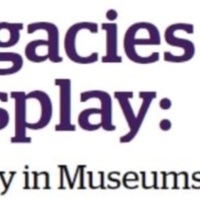
House of Negritude and Human Rights
The House of Negritude and Human Rights opened in 1971 in the former Champagney town hall. It relocated to its present site in 1995. The museum was founded after local historian René Simonin discovered a document in the Haute-Saône departmental archives. This document is known as 'Article 29' of the Champagney Register of Grievances. In 1789, the inhabitants of Champagney, drew up their list of grievances at the request of King Louis XVI. This document would be used to prepare the meeting of the Estates General that would open the process of the French Revolution. 'Article 29' was a one-of-a-kind request to abolish black slavery on humanitarian grounds.
The museum is a tribute to the "Champagnerots" (people of Champagney) who made this extraordinary request. Text interpretation explores the context of the request, examining the french slave trade and the movement for abolition in other European countries in the nineteenth century. There are artefacts that highlight the terrible conditions faced by the enslaved, including a replica slave ship and items recovered from plantations in Haiti.
The interpretation also goes on to examine other forms of slavery in the contemporary world. This is embedded into the museum's popular education programmes that reflect on the development and importance of human rights around the world.

Canadian Museum for Human Rights
Situated in Winnipeg, at the heart of the Canadian Prairies, the Canadian Museum for Human Rights is the first museum in the world solely dedicated to the past, present and future of human rights. The museum aims to create inspiring interactive experiences for its visitors in order to equip them with the tools needed to make a difference in the lives of others. It is the first museum in nearly five decades to be built outside Canada's National Capital Region, with funding from the Canadian government, after being established by legislative amendments to the Museums Act in 2008. The museum's building was purpose-built, designed to reflect the themes of the museum in the external construction, with a Hall of Hope built in luminous alabaster and outside glass wings surrounding the building represent a dove as a symbol of peace.
The Canadian Museum for Human Rights has ten core galleries as well as two spaces for temporary or travelling exhibitions. All of the displays within the museum feature diverse aspects of human rights. These include: a discursive introductory display about what human rights are, a gallery that explores the perspectives of indigenous Canadian people, and an exhibition that focusses on the stories of Canadian individuals or groups that have had their own 'journeys' with human rights challenges. Another exhibition features an overview of Canada's legal stance on human rights. Other galleries explore human rights from a more global perspective, looking at the Holocaust, other instances of genocide around the world and 'Turning Points' that have marked key changes in international human rights policy. The later galleries on the visitor route explore human rights in the present and their potential in the future, challenging visitors to take action and inspire change. All of these galleries feature the use of digital interactives, film and audio presented from lots of different perspectives, often providing the visitor an opportunity to actively participate with the theme of the exhibition. Built without a collection, the museum has filled its galleries with objects on loan from organisations around the world, both in Canada and abroad. They also have objects donated to them from the people and groups the galleries represent. The museum also has a Tower of Hope that visitors can go up, with views over the city, and an indoor garden of reflection.
The Transatlantic Slave Trade is cited as the first instance of genocide in world history in the 'Breaking the Silence' gallery which explores the role of secrecy and denial in the persecution of genocide and what happened when people spoke out or offered resistance. The centre-piece of the gallery is an interactive table that shows instances of genocide, both through time and across the world, alongside related documents and images. The 'Canadian Journeys' gallery incorporates the narrative of enslaved Africans using the Underground Railroad to escape to freedom in Canada. There are also narratives of more contemporary forms of slavery and human trafficking. Narratives of enslavement have also featured in public programmes at the museum.